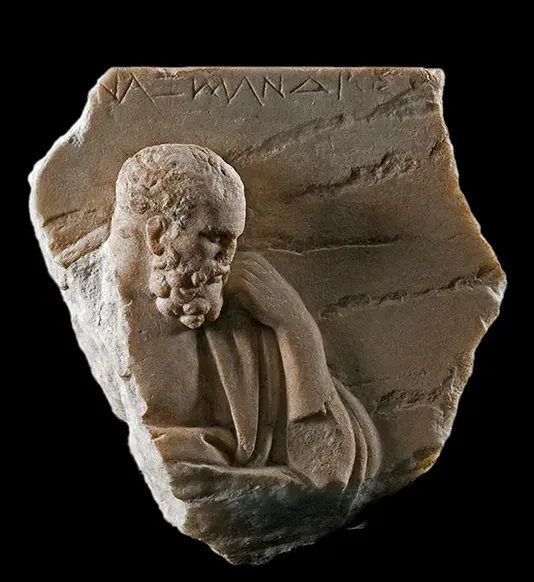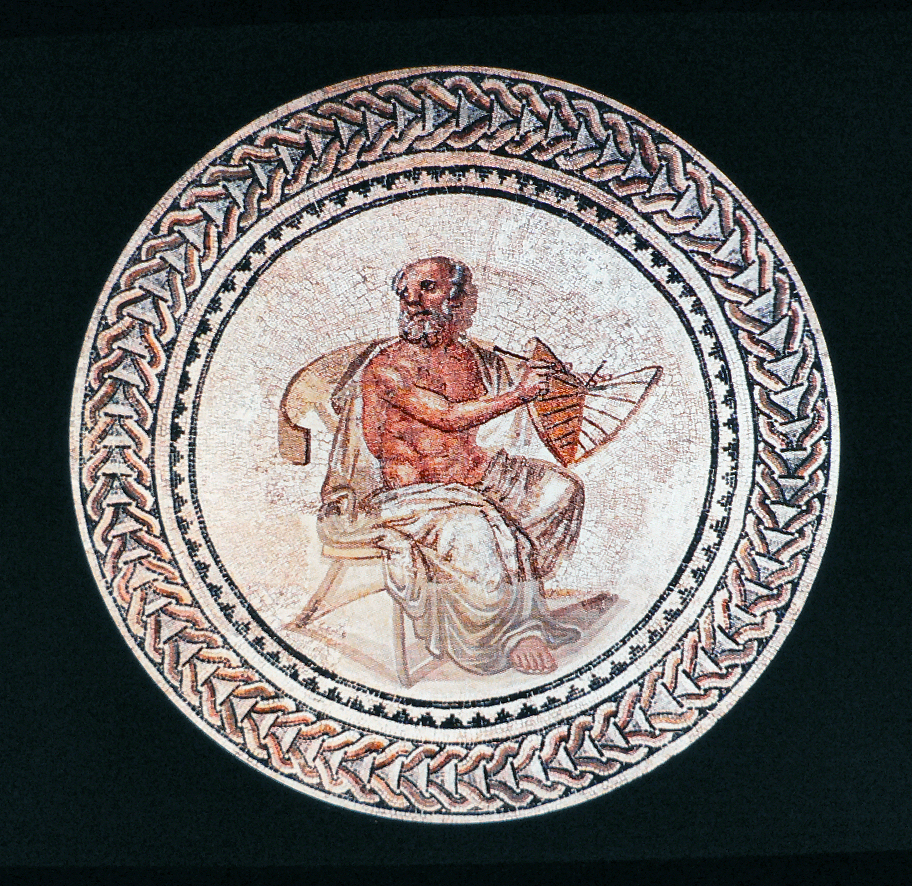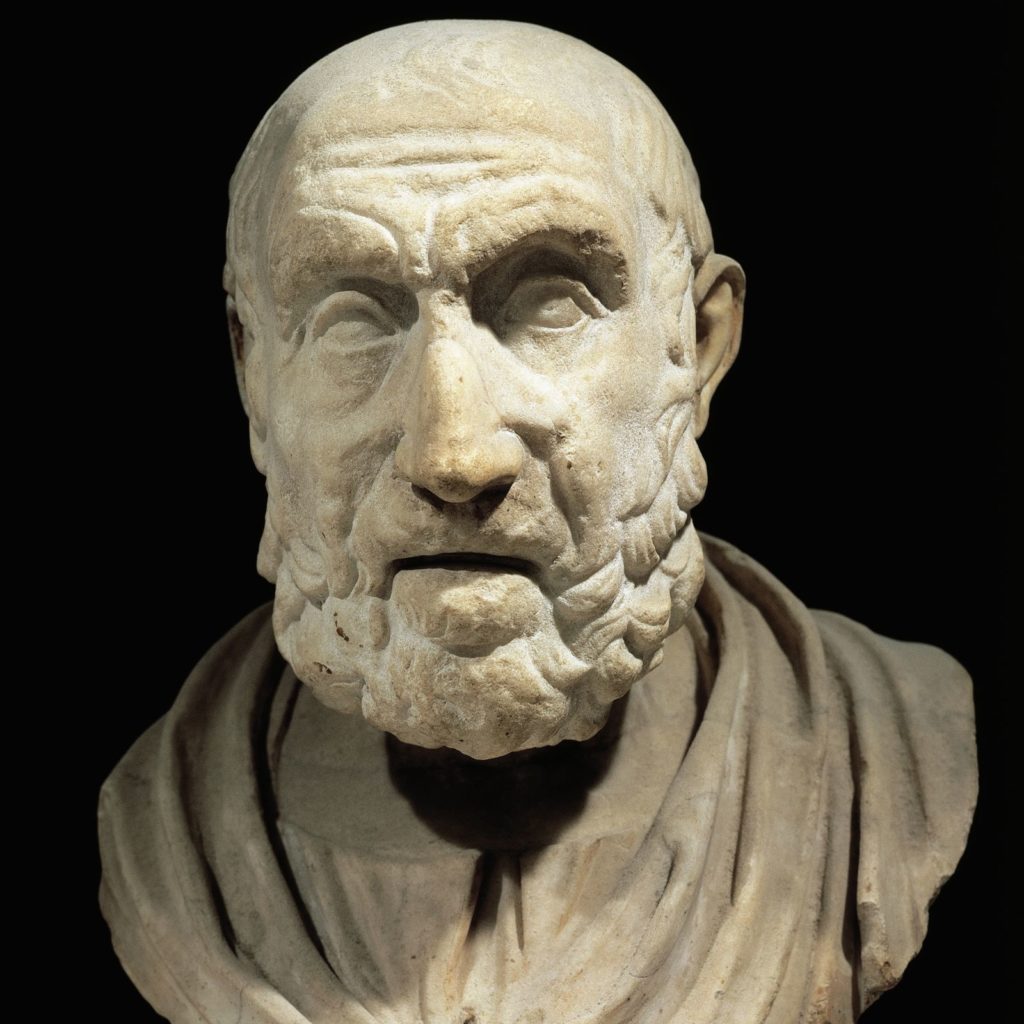
Image courtesy of J.C. Scull, Mental Illness – History and Ancient Treatments, Invisible Illness, 2022
By Walter Borden, M.D. –
In the Dark Ages of Greek ancient history (before writing), mental illness and seizure disorders were considered as demonic possession of one kind or another. Mysticism was the prevailing explanation of all unknowns. Then, in the 6th century BCE there was a burst of human genius that gave birth to western civilization. In Miletus on the coast of Asia Minor, emerged a new way of explaining, rather understanding the world. Thales, the first of what became known as the natural, or scientific, philosophers changed all of that. He revolutionized the thinking world and became the midwife to western civilization.
Thales broke from mysticism, belief in the Fates and the gods as the explanation of the world around us. He was an astronomer with a mathematic bent, keenly observant and a critical thinker. He travelled throughout the known world, from Egypt to Babylonia. He concluded it was only through free curiosity of natural phenomenon, observation, and pursuing rational explanations that nature can be understood.
It might help to know the Milesian roots of this new way of understanding. Miletus was settled after the war with Troy by Greek immigrants and in effect became the hub of trade, traffic, but most important the melting pot of cultural advances from Egypt to Mesopotamia. During the 6th century BCE there was a cross-fertilization between the Mediterranean’s vast traditional knowledge and the new culture of the developing classical Greek world. (Carlo Rovelli’s Anaximander and the Birth of Science, tr. Marion Rosenberg, Riverhead Books, Penguin / Random House, 2023). At the same time in one of those rare historical perfect storms, Miletus was also free of any priestly caste, theological censorship, or political entanglements. The people were free to think and give expression to “the Greek Mind” (H.G Kitto, The Greeks, Penguin Books, 1991, Clays Ltd. / St Ives.).

Anaximander, Museo Nazionale Romano, Rome, 1st c . CE (Image in public domain) also on cover of C. Rovelli, 2023
In brief Thales and his follower Anaximander went further. Natural laws underlie natural phenomena. The forces that shaped the world were not random. No, the forces were subject to patterns that had the strength of laws. Anaximander observed one pattern as the equilibration of forces over time There was a fundamental organizing principle that tended to equilibrium, to order. And this became what also was to become the central definition of Athenian Justice, a system to balance opposing forces or interests in the service of peaceful order. Anaximander must have communicated with Solon, must have exchanged ideas. Anaximander described this natural process of equilibration over time as dikē, the Greek word for Justice. Solon for his part designed his new constitution and justice system as tri-partite, executive, bicameral legislative, and an independent judicial. Court trials were adversarial with opposing defense and prosecution before a jury of peers and judge, mirror image of Anaximander’s conception. In nature, the judge is time.

Roman Mosaic of Anaximander, ca. 3rd c. CE, Trier Landesmuseum, (Image in public domain, courtesy of Nicolás Boullosa, “What Innovation Owes…” https://faircompanies.com/articles/what-innovation-owes-to-an-obscure-pre-socratic-philosopher/)
f there is any question about the relevance of ancient history, just look at the above: Anaximander is cited by Rovelli, today’s modern physicist, and Solon is cited by our Founders in the development of our tri-partite government (see John Adams, In Defense of the Constitution of the United States, ca 1787).

Gilbert Stuart, Portrait of John Adams, ca. 1800-15, National Gallery of Art (image in public domain)
And what Rovelli describes as scientific thinking is what Kitto describes as the Greek Mind. It is curiosity wedded to skepticism of the accepted and out of the box thinking, making for previously unrecognized connections and possibilities. Rovelli underlines the inhibitory effects of our modern infatuation with compartmentalizing, separating, in effect isolating different disciplines which may enhance concentrating focus, but which gets in the way of exploring.
But observation implies what can be seen, and by implication, measured. Mental functioning, however, is different; it is within the brain and expressed by actions, facial expressions, physiological reactions, but also hidden. When and how did the mental world, let us call it psychology, come under the sway of this new way of understanding? Let’s call it Anaximander’s way.
If we look to the formal literature of historians, sociologists, psychologists and psychiatrists. Following the time-honored practice of those disciplines we come to Hippocrates with his On the Sacred Disease. The natural outcome of that approach while it does supply an infrastructure to our psychological model, it also immediately raises problems to a sophisticated understanding of a mind-body or body mind perspective. At the time of Hippocrates entrance on the historical scene medical practice as such was a combination of mysticism and shamanism.

Hippocrates Sculptural Bust, National Gallery of Scotland (Image in public domain)
In reaction Hippocrates, or his spokes persons, outraged, published the keystone work the so-called “The Sacred Disease: On Epilepsy” stating in no uncertain terms that Epilepsy was not sacred, but a disease of the brain and not visitation by the gods. This no doubt was a result of Thales’ revolutionary views that became the basis of scientific thinking.
It also skewed understanding along physical lines of mental illness. The brain was a physical structure, and it naturally followed that other mysterious behaviors had a physical basis leading to the ancient Greek humoral theories of mental illness. A current outcome of this line of understanding is our training our high-powered technology on genes, wiring, and chemistry interacting with “environmental issues.”
Then and now tend to miss an essential lens that opens to a deeper understanding of human emotions, the inner recesses of mind. We miss the crucial contributions of the humanities, the arts, music, literature, drama, and the myriad cries for help, of pain and sadness that spill out of so many human creations.
If we focus exclusively on the philosopher scientists and those early physicians who looked to natural but exclusively physical explanations for humanity’s ills and sorrows, we will miss the early insights that Athenians were developing into the psychosocial forces shaping the individual, the family, and the community. We will overlook a completely new dimension of understanding that was taking root in man’s cultural evolution. We will bypass the dawning recognition of psychodynamics as an explanatory principle underlying relationships, behavior, conflicts, and suffering. We will miss the sprouting of psychology, anthropology, sociology, and political science. In addition, we will pass over the birth of humanism. Nor can we understand Greek psychiatric sophistication if we stop at those pre-Socratic philosophers who laid the foundation for psychology–proto-psychologists such as Anaximander, Anaxagoras, Xenophanes, and Heraclitus. We have to look further and in different places to know how firmly psychiatric principles were embedded in people’s everyday lives, and we have to find a way to examine in depth Athenian social institutions such as democracy, the polis, and the justice system in order to know their psychological underpinnings. We will find the instrument for that examination in tragic drama, which served as the herald for the polis, justice, and the dawning recognition of the science of the mind, psychology. Tragic drama is the microscope for that examination.
However, following the well-traveled path from the philosopher scientists, we do come eventually to Socrates, Plato, and Aristotle. The path from Thales to Aristotle took more than three hundred years to unfold and is the usual way to travel the road of understanding the mind through philosophy and early psychology. It is the path of conventional wisdom, but it provides a perspective that compartmentalizes and obscures the development of dynamic psychological concepts. It misses a whole vista of psychological conceptualizations as offspring of scientific thinking–conceptualizations emerging long before the time of Plato and Aristotle. Sticking to that road keeps us from traveling another path, one that courses through the dynamic psychological landscape–the path that leads to the polis, justice, and to the tragic dramatists.
A basic Hippocratic concept in the understanding of disease was the effect of the imbalance of the then known physiological processes, and of course the emotions could be one element disrupting balance. While some Hippocratic physicians were aware of the pain of loss in causing disturbances of the mind and the body, they were far outweighed by those who became side-tracked by the humoral theories which unfortunately led to a mind-body split. (see NIH History of Medicine – On the Sacred Disease,https://www.ncbi.nlm.nih.gov/pmc/articles/PMC3984878/ )
There were those who saw the role of grief, rage, malignant narcissism, and other distressing passions on disturbances of health. This should not be surprising since the tragedians presented examples of the power of emotions. Even before the tragedians there was Homer’s Iliad with forerunners of what today we call PTSD (Post-Traumatic Syndrome Disorder). Aeschylus’ Oresteia portrays the power of “frozen” grief resulting in matricide. Euripides paints the destructiveness of the abuse of women, and of course there is Sophocles and the Oedipus complex.
Psychological concepts began to be expressed some 100 to 200 years before Hippocrates. Plutarch describes a scene between Solon and Thales that sheds light on the characters of both, and their psychological sophistication. Solon is said to have asked Thales why he never married. Thales did not answer. In Plutarch’s account Thales then arranges a show rather than tell response. Their next day meeting is interrupted by a messenger from Athens who announces the murder of the son of an Athenian official. Solon assuming it is his son is overwhelmed, sinks to his knees sobbing. Thales puts his hand on Solon’s shoulder and informs him that his son lives. The messenger is an actor he hired to show Solon the pain that keeps him from having children. The reason he never married was because of his intense fear of losing a child through sickness and/or war. The ancients were keenly aware of the pain of loss and how devastating it could be. A hundred years later, Aeschylus, who lost a brother while fighting beside him at Marathon, in his Oresteia dramatized his insight into the role of unspoken, unresolved grief as a cause of madness and homicide.
The role of emotions and the pain of loss as an influence on disease was one of the principles of Hippocratic medicine. Galen, the most influential successor of Hippocrates, developed a medical niche for himself as a doctor of stress diseases. The theme of the power of grief has resonated through the ages. Shakespeare can be seen as a mirroring the tragedians. Hamlet, produced after Shakespeare lost his eleven-year-old son Hamnet, reaffirms the message that the agony of loss can be a creative power. (The recently published Hamnet by Maggie O’Farrell, 2020, has as remarkable a clinical description of grief as can be found.)
Eugene O’Neill carried on the tradition of spokesperson for the importance of grief. O’Neill lost his mother, father and brother within three years and his Long Day’s Journey Into Night, ca. 1940, is an autobiographical painting of his life. I would add that his mother suffered the death of an infant named Edmund before her pregnancy with Eugene, and while her addiction to morphine was attributed to the pain of his birth, it is also probable there was an element of post-partum depression. It is also significant that Edmund is the name of the mother’s son in Long Day’s Journey Into Night. O’Neil brought his mother’ lost son back. Other O’Neil plays can be considered as clinical expressions of mental illness.
Although unresolved grief, emotional pain, the overwhelming stress of war on health, both physical and mental, has gotten lost in scientific literature, in recent times, a psychoanalyst and internist, George Engel (The Biopsychosocial Model, 1977, https://pubmed.ncbi.nlm.nih.gov/28686557/) from the University of Cincinnati and then Rochester, developed the seminal concept of the psycho-bio-social basis of disease. He emphasized the profound psychological and physiological impact of personal loss. His initial studies explored the connection between grief and leukemia. Parkes, in England, extended Engel’s work. However, in our preoccupation with new technology and molecular pathology, we somehow have lost sight once again. Or—is it too painful?
Note: Walter Borden, M.D. is a Distinguished Life Fellow, American Psychiatric Association; Diplomate, American Board of Psychiatry and Neurology and Diplomate, American Board of Forensic Psychiatry.